
|
|
|
|
|
|
2027
Artemis III crewed mission to the lunar surface
Artemis III,* a pivotal mission in NASA's Artemis program, marks a historic return of humans to the Moon for the first time since December 1972. This follows the uncrewed test flight of Artemis I (2022) and the crewed lunar flyby achieved with Artemis II (2025).
In April 2021, NASA selected SpaceX as the contractor for the Artemis III Human Landing System (HLS). The HLS would be carried onboard SpaceX's powerful Super Heavy rocket, a part of the larger Starship launch vehicle. The crewed Orion spacecraft, delivered to the Moon via a Space Launch System (SLS) rocket, would dock in lunar orbit with the HLS, with astronauts transferring from Orion to the HLS before landing on the surface.
NASA intended for Artemis III to explore the lunar south pole; a region of great scientific interest due to the occurrence of water ice in permanently shadowed areas around it. The mission would involve two astronauts landing on the surface and staying for about a week. While up to four astronauts would launch aboard the Orion spacecraft, only two would land on the surface aboard the HLS, with two others remaining in orbit aboard Orion. Those on the surface would become the first woman and first person of colour to set foot on the Moon.
Prior to their arrival, some additional equipment is pre-positioned on the surface, including a rover to use for explorations of 5 to 15 km (3.1 to 9.3 mi) to permanently shadowed regions, where ice can be located and studied.
Artemis III is the final mission using SLS Block 1, which has a payload capacity of 27 tons (59,500 lb). The rocket is subsequently upgraded to SLS Block 1B featuring a larger and more capable Exploration Upper Stage, able to hold cargoes of up to 42 tons (92,500 lb).* This delivers the modules for assembly of a new space station in lunar orbit, known as the Lunar Gateway, as part of the Artemis IV–VI missions.
During the 2030s, an even larger variant called SLS Block 2 is used by Artemis missions VII–XI, allowing payloads of 46 tons (101,400 lb). These later missions deliver habitat modules to the lunar surface,* leading to the establishment of a permanent base.
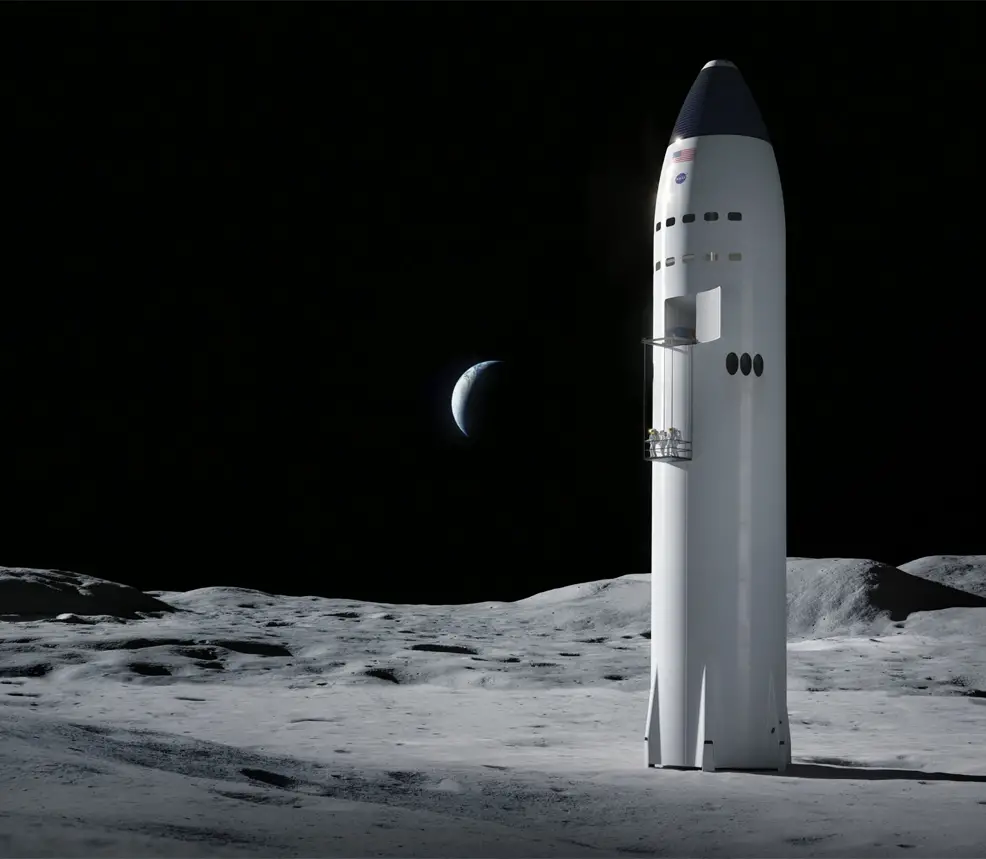
Artemis III Human Landing System (HLS). Credit: SpaceX
The EU ends all energy imports from Russia
In February 2022, Russia began a full-scale invasion of Ukraine. This led to international condemnations and sanctions, millions of displaced Ukrainians, and the largest armed conflict in Europe since World War II.
The US and UK announced a ban on Russian oil, while the EU announced a two-thirds reduction in its demand for Russian gas. Oil companies Shell, BP, and ExxonMobil suspended all operations in the country. German Chancellor Olaf Scholz, previously in favour of the newly completed Nordstream 2 gas pipeline between Russia and Germany, suspended certification of the project indefinitely.
Amid soaring energy prices, Russia's continued aggression against its neighbour, and longer-term concerns over climate change impacts, the EU proposed to go even further than its earlier announcement. The bloc's leaders began drafting a plan to end their reliance on all Russian energy sources by 2027. Finalised in May, the REPowerEU project* would completely phase out Russian gas, oil, and coal imports, while accelerating the green transition.
Until this point, Russian fossil fuels had been used as an economic and political weapon, costing the EU nearly €100 billion per year. The bloc depended on Russia for about 40% of its gas, 27% of its oil, and 46% of its coal imports. The REPowerEU plan included measures to boost energy savings, diversify energy supplies, and accelerate the roll-out of renewable energy – all of which could strengthen economic growth, security, and climate action for Europe and its partners.
The energy saving aspect included raising the Energy Efficiency Target for the European Green Deal (a set of policy initiatives by the European Commission approved in 2020), from 9% to 13%. Fiscal measures included reduced VAT rates on energy efficient heating systems, building insulation, and appliances.
The energy diversification aspect would ensure the EU worked with reliable and trusted international partners to minimise supply disruptions. In addition to new gas pipeline deliveries and LNG imports, this included major developments with hydrogen, continuing beyond 2027.
Finally, and most notably, the REPowerEU project called for a massive scaling-up of renewables. It proposed a doubling of solar capacity by 2025 and a further 600GW by 2030, a legal obligation to install solar panels on all new buildings, a doubling of the rate of deployment of heat pumps and measures to boost both geothermal and solar thermal, shortened and simplified approvals for major renewable projects, and a target of 10 million tons of domestic hydrogen production for use in hard-to-decarbonise industries and transport sectors.
By 2027, the EU has invested €210 billion ($225 billion) in upgrading its energy infrastructure, allowing it to completely end any dependence on Russia for imports of oil, gas, and coal.*
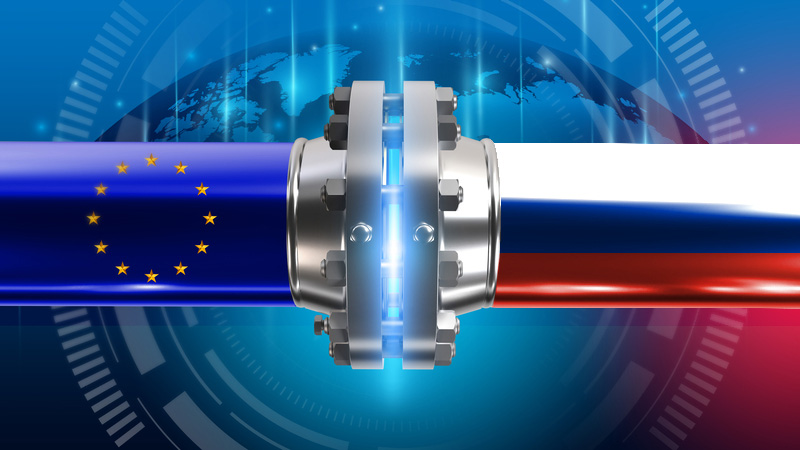
EU/Russia 2027 – Illustration 247886273 © Leestat | Dreamstime.com
Light-duty hydrogen fuel cell vehicles reach 1 million in annual sales
The first vehicles powered by hydrogen fuel cells emerged during the Cold War Space Race. These were bulky, inefficient and expensive, however. It was not until the dawn of the 21st century that car manufacturers began to take the concept more seriously.
In 2003, President George Bush proposed the Hydrogen Fuel Initiative (HFI), which was later implemented by legislation through the 2005 Energy Policy Act and the 2006 Advanced Energy Initiative. This aimed to further develop hydrogen fuel cells and infrastructure with the goal of producing commercial fuel cell vehicles. By 2008, over $1 billion had been contributed to the project.
However, the U.S. Department of Energy later shifted its interest from fuel cells to battery vehicles. High costs and the lack of infrastructure were major problems, compounded by the challenge of deploying fuel stations over such a large geographical area. This led U.S. automakers to delay their hydrogen vehicle rollouts. The situation was different in Europe, however – with less geography to cover – and where governments had serious plans to develop the required infrastructure.* Japan and South Korea, too, had similar initiatives getting underway.
In addition to expanded infrastructure, further advances in technology reduced the size, weight and cost of hydrogen fuel cell vehicles.* By 2027, global sales of these non-polluting vehicles have reached one million annually for the first time.* Although still only a tiny proportion of total, overall vehicle sales, the industry is now entering a period of explosive growth.*
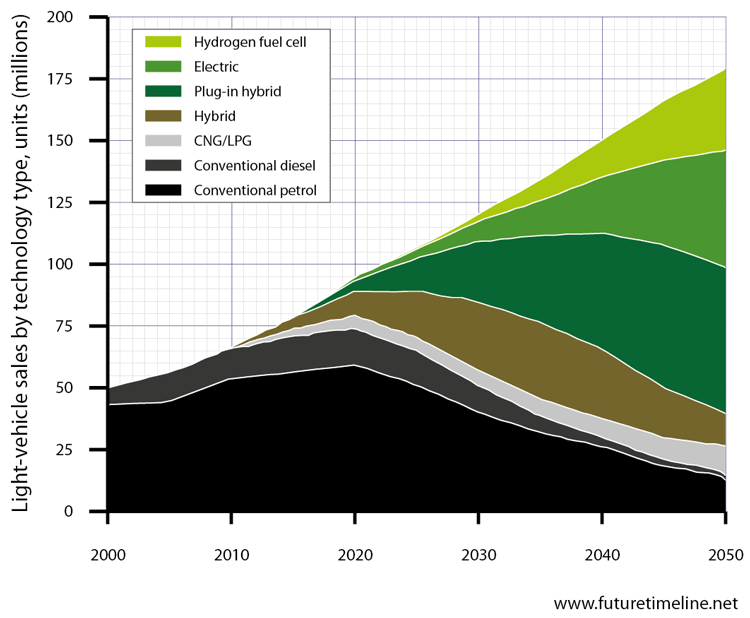
Tokyo and Nagoya are connected by high-speed maglev
Two of Japan's largest cities – Tokyo and Nagoya – are now connected by the Chūō Shinkansen – a high speed maglev route. This 178 mile (286 km) line runs beneath the Japanese Alps (Akaishi Mountains), at speeds of up to 313 mph (505 km/h), enabling journey times of just 40 minutes. Built by the Central Japan Railway Company, at a cost of 9 trillion yen ($115bn), the route will be extended to Osaka by 2045.**

The Venera-D mission arrives at Venus
Venera-D is a Russian space probe sent to study the atmosphere and surface of Venus. The primary aim of the mission is to understand the history and evolution of the planet. Venera-D was first proposed to the Russian Academy of Sciences in 2003, with a planned launch date of 2013. The original design featured a large orbiter, sub-satellite, two balloons, two small landers and one larger, longer-lived lander. However, it was scaled down and delayed until the late 2020s. The final configuration would have two components: one orbiter and one lander.
The spacecraft is launched in 2026, arriving in 2027.* The orbiter includes several spectrometers, a plasma package and camera. Its radar remote-sensing equipment is far more powerful than the Venera 15 and 16 probes of the 1980s and the NASA Magellan in the 1990s. A wealth of new data is gathered to more accurately characterise the composition of the atmosphere, clouds and their structure, radiative balance and the nature of the greenhouse effect, ionosphere, magnetosphere and electrical activity, along with the gas escape rate in the upper atmosphere. This reveals new insights into the early history of Venus and the oceans of water it held in the ancient past.* Knowledge is also gained about the nature of "super-rotation" – a phenomenon in which the atmosphere circles the planet in just four Earth days, far faster than the sidereal day of 243 days – but decreases at lower altitudes, so that wind speeds barely reach 10 km/h (6 mph) on the surface.
In addition to the orbiter is a lander, which investigates one of the planet's tesserae. These are regions of very old, heavily deformed terrain characterised by intersecting tectonic elements, high topography and high radar backscatter. This becomes the first probe to successfully touch down on Venus's surface since the Soviet Union's Vega 2 mission, 42 years earlier in 1985. It features a high-resolution camera to obtain panoramic images of both its descent through the atmosphere and the surroundings at ground level. The lander investigates the structure and chemical composition of the atmosphere and performs chemical analysis of surface materials. The interaction between the surface and the atmosphere is studied. The lander also characterises the geology of local landforms at different scales.
Due to the hellish conditions on Venus (temperatures of 462 °C, atmospheric pressure 92 times that of Earth, and clouds of sulphuric acid), the lander was originally expected to last for only one or two hours. However, with new materials and more robust electronic systems, it is redesigned to survive longer than any previous mission. This is helped in part by a collaboration with NASA, who supply a number of components.*
Venera-D is the first in a new generation of Russian probes to Venus. The mapping data obtained by the orbiter is used to determine the location of potential future landing sites. These follow-up missions also include sensors designed to search for signs of life in the mid-level atmosphere, which is seen as a possible habitat for extremophile organisms.*
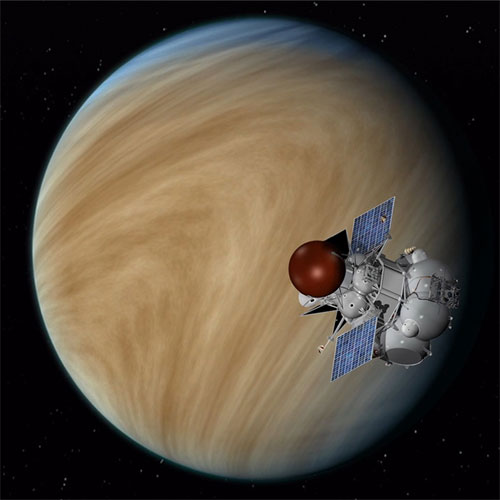
Credit: NASA/JPL-Caltech
Launch of the Nancy Grace Roman Space Telescope
In 2027, NASA launches a new space telescope. The Nancy Grace Roman Space Telescope – formerly known as the Wide Field Infrared Survey Telescope (WFIRST) – is named after the first female executive at NASA, who served as the agency's Chief of Astronomy throughout the 1960s and 70s and played a key role in planning for the Hubble Space Telescope.
Shortened as "Roman", or the Roman Space Telescope, its five-year mission aims to address cutting-edge questions in two main areas: the universe and exoplanet research. By measuring the precise distances and shapes of millions of galaxies, it provides insights into dark energy, the mysterious force that is accelerating the expansion of the universe. It probes the chronology of the universe, the growth of cosmic structure, the consistency of general relativity, and the curvature of spacetime. In addition, it finds thousands of new exoplanets, using the microlensing technique, which includes planets with masses as small as Mars, as well as free-floating or "rogue" planets. This complements the discoveries made by other telescopes like Kepler, TESS, and the next generation of missions, providing a better picture of the population of exoplanets in our galaxy. It also sets new records for the farthest-known exoplanets – offering a glimpse of some different galactic neighbourhoods, far away from the 5,500 already known exoplanets.
Placed in a halo orbit around Sun-Earth Lagrange point L2, Roman carries two scientific instruments. The first is Wide-Field Instrument, a 300-megapixel camera providing multiband visible to near-infrared images, able to capture 100 times the area of Hubble's camera. Roman also features 1,500 times the surveying speed of that earlier telescope. Its second instrument is Coronagraphic Instrument (CGI), a high contrast coronagraph designed to achieve a part-per-billion suppression of incoming starlight, enabling the detection and imaging of planets with a visual separation of as little as 0.15 arcseconds from their host stars.
In addition to its two primary missions, Roman performs stellar seismology studies on a million giant stars. This involves analysing brightness changes caused by sound waves echoing through a star's gaseous interior to learn about its structure, age, and other properties. It also identifies over a thousand neutron stars, hundreds of stellar-mass black holes, and thousands of Kuiper belt objects including some as small as 9.7 km (6 mi) across (about 1% of Pluto's diameter).
The combination of its gigantic field of view and ultra-precise coronagraph makes the Roman Space Telescope a unique and powerful tool for astrophysics, contributing to many exciting discoveries in the late 2020s and early 2030s.*
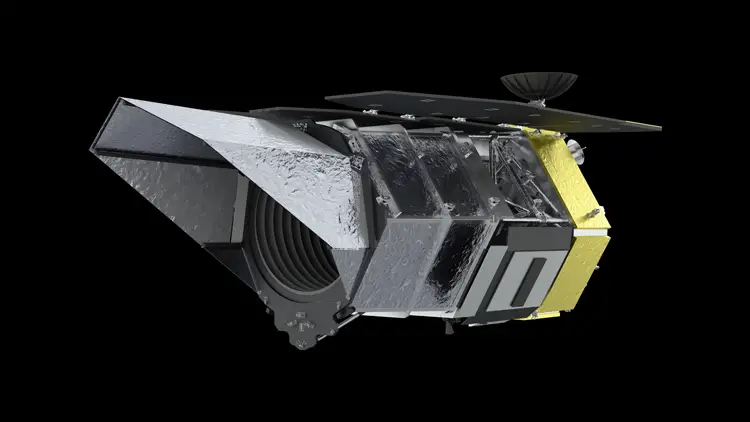
Credit : GSFC/SVS
The asteroid 1999 AN10 makes a close approach
1999 AN10 is an asteroid of the Apollo group, a collection of Earth-crossing bodies, many of which are large enough and can drift close enough to Earth to be considered potentially hazardous. It was discovered by U.S. scientists on 13th January 1999. The object was estimated to have a diameter of up to 1,800 m (5,905 ft), or about a mile – enough to cause continent-scale devastation, should an impact occur on Earth.
AN10 circles the Sun every 643 days and twice each year passes through the Earth's local neighbourhood. On 7th August 2027, it makes a particularly close approach as it comes within just 0.0026 AU (390,000 km; 240,000 mi), about the same as the distance between the Earth and Moon. The asteroid reaches a peak apparent magnitude of 7.3, bright enough to be visible in binoculars. Its orbit remains dangerously close for the next 600 years.*
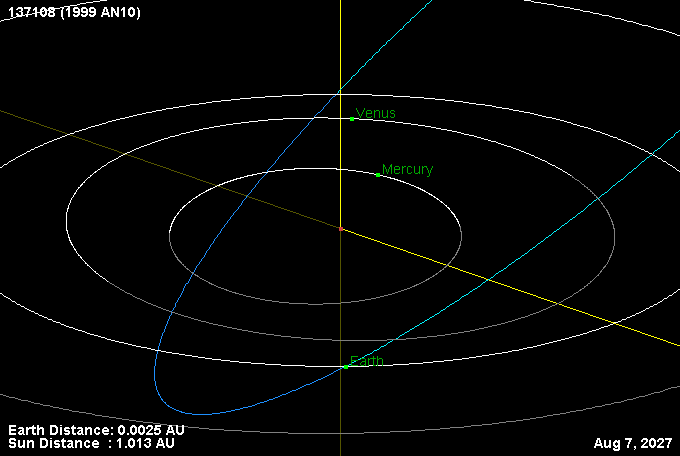
The Square Kilometre Array begins science operations
Humanity's view of the universe is greatly expanded with the completion of a major new observatory. The Square Kilometre Array (SKA) is a radio telescope with a combined collecting area of approximately one kilometre. It operates over a wide range of frequencies and its size makes it 50 times more sensitive than any other comparable instrument. By utilising advanced processing technology, it can survey the sky more than 10,000 times faster than ever before. With additional stations extending to a distance of 3,000 km from a concentrated central core, it continues radio astronomy's tradition of providing the highest resolution images in all of astronomy. First light is achieved in 2027* and the telescope is fully operational by 2030.
Click to enlarge

Image used with permission from Jo Bowler, SKA Program
Development Office, Jodrell Bank Centre for Astrophysics.
User-replaceable batteries are mandated in the EU
During the 2010s, manufacturers of smartphones, tablets, laptops and other devices increasingly made batteries non-removable. When Apple introduced new MacBooks with sealed-in batteries, it greatly improved their battery life and established a trend that other companies soon followed. The Samsung Galaxy S5, released in 2014, became one of the last flagship phones with a removable battery, after which permanently built-in, non-replaceable batteries became the norm.
Several motivations lay behind this change. For instance, without the need to accommodate a removable battery compartment, designs could be simpler, and devices made both slimmer and lighter. Batteries could take on different physical forms and be larger, charge more quickly, and handle a much greater number of charge cycles.
However, this trend met with resistance due to the inconvenience and a number of potential issues. If sealed-in batteries failed, it would require sending the device back to a vendor or technician, causing significant delays for users. In some cases, if the battery swelled over time, it might damage sensitive components of the device. Users criticised what they increasingly saw as a form of planned obsolescence, while environmental campaigners also noted its contribution to the growing mountains of e-waste.* These and other problems led to calls for regulation to reverse this trend.
In 2023, responding to these concerns, the European Union (EU) proposed a mandate for user-replaceable batteries in all devices by 2027.* New rules would cover the design, production, and recycling of all rechargeable batteries sold within the EU – stipulating that for "portable batteries" used in devices such as phones, tablets, and cameras, consumers must be able to "easily remove and replace them." This would require a significant design rethink by manufacturers. Additionally, the European Parliament had plans for non-rechargeable batteries, with a phase out to be decided on by 2030.

2D barcodes are ubiquitous in retail
The first traditional barcode was invented in the 1940s by Norman Joseph Woodland and Bernard Silver, two graduate students in Philadelphia, USA. Their original design consisted of a series of concentric circles that could be read by a scanner using ultraviolet light. In the 1960s, Woodland and Silver refined their design and developed the modern barcode, consisting of a series of lines and spaces of varying widths. They also developed a scanner that could read the barcode using visible light, and a system for assigning unique identification numbers to products. This would later become known as the Universal Product Code (UPC).
In 1972, the UK supermarket chain Sainsbury's introduced a barcode system to help manage inventory more efficiently, using the UPC. In 1974, a pack of Wrigley's chewing gum became the first product to be sold with a barcode, when scanned at a supermarket in Ohio, USA. Barcodes soon became an integral part of the retail industry, used to identify and track products in stores and warehouses around the world.
In 1994, Toyota subsidiary Denso Wave invented the first 2D barcode, embedding data on both the horizontal and vertical axes, as a way to track vehicle parts during the manufacturing process. The Quick Response (QR) code which the company developed saw widespread adoption in Japan, alongside many other types of 2D barcode (also known as matrix codes).
In contrast to linear (1-dimensional) barcodes, this new format could represent far more data per unit area. Whereas a standard barcode typically had only 12 to 20 digits, a QR code had capacity for more than 4,000 alphanumeric or 7,000 numeric characters.
More significantly, however, the number of possible combinations became astronomically higher. UPC-A, the most common of 1D barcodes, had about a trillion (1012) possible combinations. The initial version of QR codes released in 1994 featured 21 x 21 modules (black and white squares), which increased to 177 x 177 with version 40 in 2015. This enabled 109403 possible combinations – more than the total number of atoms in the known Universe, ensuring that humanity would never run out of codes.

Credit: GS1
After gaining popularity in Japan, QR codes and other 2D barcode formats began spreading to countries around the world. In the 2010s, they became even more widely used due to the prevalence of smartphones with cameras and code scanning capabilities. The COVID-19 pandemic of 2020 further increased their appeal, as a "touchless" system to display information.
With 2D barcodes already widespread in manufacturing, warehousing, logistics, healthcare, and other industries, attention now focused on the retail sector to make its older barcode system fit for the 21st century. These efforts included Sunrise 2027 proposed by GS1 US, a non-profit standards organisation, along with initiatives in other countries, aiming to have all shops and point-of-sale (POS) terminals set up and ready to accept 2D barcodes.
By 2027, this upgrade is largely complete.* The use of 2D barcodes in retail offers more data capacity, interactive capabilities, enhanced tracking and traceability, and cost-effectiveness.
For instance, more information can be stored about a product, such as nutritional content, ingredient lists, and allergen information. This can be crucial for customers with dietary restrictions or allergies, and helps promote transparency and trust between customers and food producers. The codes can be used to create interactive experiences for customers, such as providing recipes, games, or discounts and loyalty rewards.
They also help shops and food producers gather valuable data and insights into customer preferences and behaviour. Individual food products can be tracked and traced throughout the supply chain, from farm to table. This helps improve food safety and quality control, and can also help reduce food waste by identifying and addressing inefficiencies in the supply chain. Information can also be provided on sustainability practices.
The autopsy report for Elvis Presley is made public
Elvis Presley was one of the 20th century's most iconic singers, often referred to as the "King of Rock and Roll", or simply "the King". After cementing his place among the legends of American music, his final years were marked by serious health problems. These were aggravated, and possibly caused by, drug dependence. On 16th August 1977, Presley was found unresponsive on the bathroom floor of his Graceland home. Attempts to revive him failed, and death was officially pronounced at 3:30pm at Baptist Memorial Hospital, Tennessee.
Controversy surrounded the autopsy and its aftermath as the competence and ethics of two medical professionals were questioned. One had his licence permanently revoked, after charges were brought by the Tennessee Medical Board. An overdose of prescription drugs (including codeine, Demorol, morphine and Valium, to name a few) had apparently caused Elvis' heart to beat irregularly and then stop. However, rumours of a cover-up were rife as the exact cause of death remained unclear. Vernon Presley, Elvis' father, had the complete autopsy report sealed for a period of 50 years.
The controversy surrounding the autopsy – as well as various other questionable circumstances – led conspiracy theorists to proclaim that the King was still alive. After his funeral, there were numerous alleged sightings of Presley. A long-standing theory among fans was that he had faked his own death. Some fans noted apparent discrepancies in the death certificate, a curious different spelling of the middle name on his gravestone, him reportedly cutting family members out of his will shortly before he died, rumours of a wax dummy in his original coffin and numerous accounts of Presley planning a diversion so he could retire in peace.
The full autopsy report is finally made public on 16th August 2027, exactly half a century after Presley's death.*

Opening of the New Central Polish Airport
The New Central Polish Airport (also known as "Solidarity Transport Hub") is a megaproject to construct a new, built-from-scratch airport located 40 km southwest of Warsaw, Poland. This replaces the aging and overcrowded Warsaw Chopin Airport.
Initially opening with two runways and a capacity of 45 million passengers per year, a substantial upgrade occurs in subsequent years – boosting its capacity to around 100 million, with four runways. Alongside a major expansion of the surrounding rail network, this forms the largest transportation hub in central and Eastern Europe, serving as a gateway to and from Asia. In terms of total passenger numbers, it eventually rivals some of the busiest airports in the world, including the likes of Hartsfield–Jackson in Atlanta, Beijing Capital International Airport, and Dubai International Airport.
More than 100 Polish cities throughout the country receive a direct rail link to the new airport, allowing for connections to the airport-rail hub from the most important urban centres in Poland. This includes high-speed routes, with trains running at 250 km/h (155 mph) on some sections.
The project faces considerable opposition from local residents, as well as concerns over its financial viability, but is approved by the government. A series of design concepts by world-leading architects emerged in 2019, with a winning candidate selected in 2020.* Costing 35 billion złoty ($9.4 billion), the initial phase completes construction by 2027.*
Other airports in Europe are undergoing major expansions in this decade, as global demand for air travel continues to increase. For example, a third runway opens at Heathrow Airport, London, in 2029. The New Central Polish Airport allows Poland to compete with western European countries on the aviation market and establish a greater share of international traffic. This generates an extra $7 billion in annual GDP and 65,000 new Polish jobs by 2035.
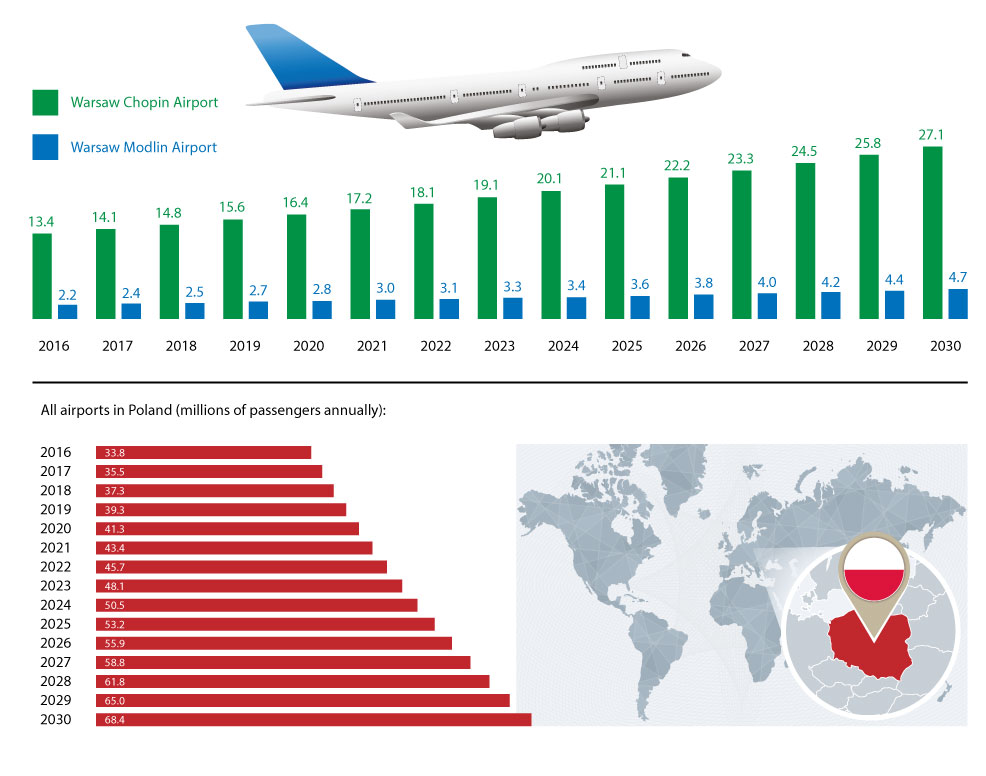
Bougainville becomes an independent country
Bougainville, a region to the east of Papua New Guinea's mainland, was first inhabited by humans in about 27,000 BC. During the colonial period, it was occupied and administered at various times by the Australians, Germans, and Japanese. It was the scene of major land and naval battles in World War 2 between the Allies and the Empire of Japan.
After the Japanese surrendered, Australia resumed administrative control of Papua and New Guinea, including Bougainville, under a UN trusteeship. However, Papua New Guinea established its sovereignty in 1975 and became an independent Commonwealth realm, with Elizabeth II as its queen. A few factions in Bougainville had already demanded independence and unilaterally declared it, now naming their territory the Republic of the North Solomons, although this was not internationally recognised. Following 11 months of negotiations with Prime Minister Michael Somare, Bougainville agreed to remain part of Papua New Guinea after being granted a degree of autonomy through a provincial system of government.
A civil war erupted in 1988, triggered by grievances primarily related to the social and environmental impacts of the Panguna copper and gold mine, which was operated by an Australian company. One of the world's largest and most profitable open-cut mines, it produced 45% of Papua New Guinea's export revenue and 12% of its GDP. But although its government was a 20% shareholder, the local population received only 1% of the profit share, which led to growing resentment. The conflict escalated into a full-scale civil war, involving Bougainville Revolutionary Army rebels, Papua New Guinea defence forces, and various other factions. The war lasted for 10 years and was devastating, resulting in an estimated 15,000 to 20,000 deaths and displacing many more.
In 2001, a peace agreement was reached, leading to the creation of an Autonomous Bougainville Government. This granted the region greater autonomy and paved the way for a future referendum on independence. As part of the agreement, Bougainville would be allowed to hold a non-binding vote to gauge public sentiment on independence versus greater autonomy within Papua New Guinea.
On 23rd November 2019, Bougainville finally held this referendum, in which an overwhelming 98.3% voted in favour of full independence, as opposed to merely greater autonomy. This result set the stage for ongoing consultations between Bougainville and the government of Papua New Guinea about its future status.
Negotiations formally began on 17th May 2021. While the President of Bougainville, Ishmael Toroama, stated a desire to see Bougainville become independent by June 2025, Papua New Guinea's Prime Minister, James Marape, cautioned against setting a specific timetable. On 7th July 2021, it was announced that Bougainville would become independent by the end of 2027, pending ratification from Papua New Guinea's parliament.
Today, in 2027, the world is welcoming its newest country: Bougainville,* which becomes the 196th member of the United Nations. The 20th century had seen worldwide geopolitical upheaval, resulting in the creation of dozens of new countries, but in the 21st century this has been a much rarer event. Bougainville joins only a handful of other sovereign states to have emerged in recent decades: East Timor (2002), Montenegro (2006), Serbia (2006), and South Sudan (2011).
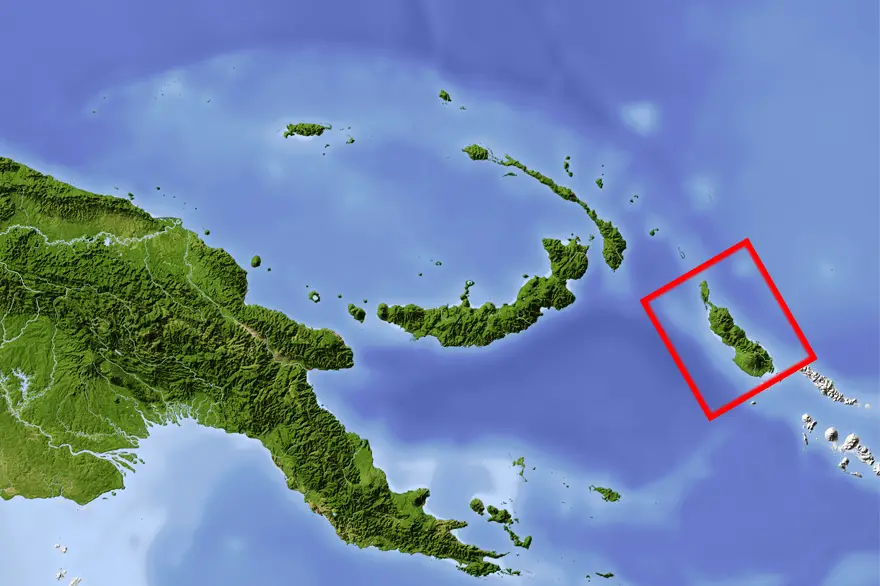
Completion of the Australia–ASEAN Power Link
The Australia–ASEAN Power Link (AAPL) is a clean energy megaproject that includes the world's largest solar plant, the world's largest battery, and the world's longest submarine power cable.
The solar photovoltaic (PV) plant is located near Elliott in Australia's Northern Territory. The PV modules cover 12,000 hectares (30,000 acres) in a region with some of the best sunlight in the world, which enables a generating capacity of 10,000 MW. For comparison, the largest operating solar farm in 2020, the Bhadla Solar Park in northwest India, had a nameplate capacity just 22.4% as high. With a total area of 120 km², the AAPL is large enough to be visible from space.
Running north from the AAPL is a high-voltage, direct current (HVDC) transmission line, which delivers electricity for export to southeast Asia. This passes through Darwin on Australia's north coast, before continuing as an undersea power cable, stretching a total of 4,500 km (2,800 mi). Most of the exported power is supplied to Singapore, enough to provide 20% of the city's total electricity. Batteries in both Darwin and Singapore produce load-balancing of 30GWh to account for variability in sunlight and energy demand, ensuring a continuous supply.
Developed by Sun Cable, a Singaporean firm founded in 2018, the total cost of the AAPL is S$22 billion (US$16.5 billion). Construction begins in mid-2023 with operations starting in early 2026 and full completion by late 2027.**
With its sheer size, capacity, and cable length, the AAPL forms the major backbone of a continent-wide supergrid that emerges in Australasia and Oceania during the mid-21st century. Further into the future, this vast electrical infrastructure is boosted even more, by the addition of room-temperature superconductors that provide lossless transmission.*
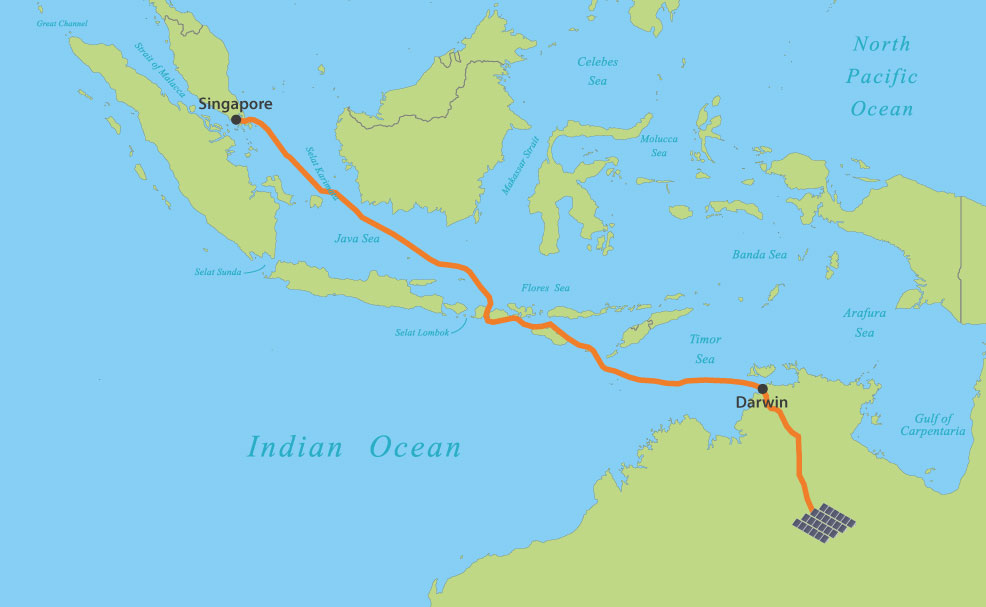
« 2026 |
⇡ Back to top ⇡ |
2028 » |
If you enjoy our content, please consider sharing it:
References
1 "...if the HLS development takes as many months as NASA major projects do, on average, the Artemis III mission would likely occur in early 2027."
See GAO report warns Artemis 3 landing may be delayed to 2027, SpaceNews:
https://spacenews.com/gao-report-warns-artemis-3-landing-may-be-delayed-to-2027/
Accessed 14th January 2024.
2 Space Launch System – Block variants, Wikipedia:
https://en.wikipedia.org/wiki/Space_Launch_System#Block_variants
Accessed 14th January 2024.
3 Artemis Program – Artemis 7–11, Wikipedia:
https://en.wikipedia.org/wiki/Artemis_program#Artemis_7%E2%80%9311
Accessed 14th January 2024.
4 REPowerEU: A plan to rapidly reduce dependence on Russian fossil fuels and fast forward the green transition, European Commission:
https://ec.europa.eu/commission/presscorner/detail/en/ip_22_3131
Accessed 29th May 2022.
5 Europe sets 2027 deadline to end reliance on Russian oil and gas, CNN:
https://edition.cnn.com/2022/03/11/energy/europe-russia-energy-end-date/index.html
Accessed 29th May 2022.
6 "...break even could come as early as 2027."
See Report: Over 1.5 MILLION UK drivers will have hydrogen cars by 2030, The Register:
http://www.theregister.co.uk/2013/02/04/hydrogen_could_be_mainstream_car_fuel_by_2030/
Accessed 18th August 2013.
7 Why Toyota and GM Are Pushing Fuel-Cell Cars to Market, Technology Review:
http://www.technologyreview.com/news/516711/why-toyota-and-gm-are-pushing-fuel-cell-cars-to-market/
Accessed 18th August 2013.
8 Fuel Cell Vehicles, Navigant Research:
http://www.navigantresearch.com/wp-assets/uploads/2013/05/FCV-13-Executive-Summary.pdf
Accessed 18th August 2013.
9 Daily chart: Tomorrow's ride, The Economist:
http://www.economist.com/blogs/graphicdetail/2013/04/daily-chart-15?fsrc=scn/gp/wl/dc/tomorrowride
Accessed 18th August 2013.
10 Japan Flashes Green Signal for Maglev Train Line, Environmental News Service:
http://ens-newswire.com/2011/05/30/japan-flashes-green-signal-for-maglev-train-line/
Accessed 3rd January 2018.
11 Chūō Shinkansen, Wikipedia:
http://en.wikipedia.org/wiki/Ch%C5%AB%C5%8D_Shinkansen
Accessed 14th December 2011.
12 Venera-D, Wikipedia:
https://en.wikipedia.org/wiki/Venera-D
Accessed 2nd April 2018.
13 NASA Climate Modeling Suggests Venus May Have Been Habitable, NASA:
https://www.nasa.gov/feature/goddard/2016/nasa-climate-modeling-suggests-venus-may-have-been-habitable
Accessed 2nd April 2018.
14 Russia and America Are Collaborating on the Most Ambitious Venus Mission Ever, MotherBoard:
https://motherboard.vice.com/en_us/article/4x9wqw/russia-america-venera-d-nasa-russian-academy-of-sciences-venus
Accessed 2nd April 2018.
15 Is there life adrift in the clouds of Venus?, Astrobiology Magazine:
https://www.astrobio.net/also-in-news/is-there-life-adrift-in-the-clouds-of-venus/
Accessed 2nd April 2018.
16 Roman Space Telescope, NASA:
https://roman.gsfc.nasa.gov/index.html
Accessed 31st October 2023.
17 Earth set for close asteroid encounter, BBC:
http://news.bbc.co.uk/1/hi/sci/tech/318969.stm
Accessed 25th July 2016.
18 Square Kilometre Array, Wikipedia:
https://en.wikipedia.org/wiki/Square_Kilometre_Array
Accessed 26th April 2020.
19 Planned obsolescence: the outrage of our electronic waste mountain, The Guardian:
https://www.theguardian.com/technology/2020/apr/15/the-right-to-repair-planned-obsolescence-electronic-waste-mountain
Accessed 23rd June 2023.
20 EU: Smartphones Must Have User-Replaceable Batteries by 2027, PCMag:
https://uk.pcmag.com/batteries-power/147382/eu-smartphones-must-have-user-replaceable-batteries-by-2027
Accessed 23rd June 2023.
21 QR-style "2D barcodes" will revolutionize retail as we know it, Axios:
https://www.axios.com/2023/04/17/2d-barcode-transition-2027
Accessed 3rd May 2023.
22 On His 80th Birthday, Revisiting the Conspiracies That Have Kept Elvis Presley Alive, Newsweek:
http://www.newsweek.com/his-80th-birthday-revisiting-conspiracies-have-kept-elvis-presley-alive-297968
Accessed 31st October 2015.
23 A new airport in Poland could become one of the busiest in the world – these design concepts give a first glance at how it could look, Business Insider:
https://www.businessinsider.com/first-look-new-transport-hub-in-poland-could-be-worlds-biggest-airport
Accessed 12th July 2019.
24 Poland Wants Its Planned Airport to Be a European Gateway to Asia, Bloomberg:
https://www.bloomberg.com/news/articles/2018-09-11/poland-wants-share-of-asian-flight-boom-with-airport-hub-project
Accessed 12th July 2019.
25 Bougainville: A New Country Coming in 2027, YouTube:
https://www.youtube.com/watch?v=1Fb0KNhsARo
Accessed 23rd August 2023.
26 Australia's Ambitious $16 Billion Solar Project Will Be The World's Biggest, OilPrice.com:
https://oilprice.com/Alternative-Energy/Renewable-Energy/Australias-Ambitious-16-Billion-Solar-Project-Will-Be-The-Worlds-Biggest.html
Accessed 24th November 2020.
27 Australia-ASEAN Power Link, Sun Cable:
https://www.suncable.sg/
Accessed 24th November 2020.
28 Superconductivity achieved at 15°C, Future Timeline Blog:
https://www.futuretimeline.net/blog/2020/10/17-room-temperature-superconductor-future-timeline.htm
Accessed 24th November 2020.
![[+]](https://www.futuretimeline.net/images/buttons/expand-symbol.gif)






